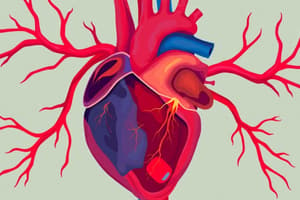Podcast
Questions and Answers
Which of the following statements accurately describes the relationship between changes in ESV and EDV?
Which of the following statements accurately describes the relationship between changes in ESV and EDV?
- An increase in ESV leads to a decrease in EDV.
- Changes in ESV and EDV are independent of each other.
- An increase in EDV leads to a decrease in ESV.
- An increase in ESV leads to a compensatory increase in EDV. (correct)
What is the normal range for left ventricular ejection fraction (EF)?
What is the normal range for left ventricular ejection fraction (EF)?
- 55-70% (correct)
- 45-55%
- 70-85%
- 30-45%
Which of the following formulas correctly represents the calculation for ejection fraction (EF)?
Which of the following formulas correctly represents the calculation for ejection fraction (EF)?
- EF = EDV - ESV
- EF = EDV + ESV
- EF = SV / EDV (correct)
- EF = ESV / EDV
What factor primarily affects changes in stroke volume (SV)?
What factor primarily affects changes in stroke volume (SV)?
Which of the following is true about ejection fraction (EF)?
Which of the following is true about ejection fraction (EF)?
What is the relationship between changes in SV and EDV?
What is the relationship between changes in SV and EDV?
What is the primary factor affecting changes in stroke volume (SV)?
What is the primary factor affecting changes in stroke volume (SV)?
What is the formula for calculating ejection fraction (EF)?
What is the formula for calculating ejection fraction (EF)?
How are changes in ejection fraction (EF) primarily influenced?
How are changes in ejection fraction (EF) primarily influenced?
Which of the following is the correct definition for Stroke Volume (SV)?
Which of the following is the correct definition for Stroke Volume (SV)?
What is the relationship between Venous Return (VR) and Stroke Volume (SV)?
What is the relationship between Venous Return (VR) and Stroke Volume (SV)?
What is the relationship between Afterload and Stroke Volume (SV)?
What is the relationship between Afterload and Stroke Volume (SV)?
What is the relationship between Inotropy (Contractility) and Stroke Volume (SV)?
What is the relationship between Inotropy (Contractility) and Stroke Volume (SV)?
Which of the following is the correct definition for Cardiac Output (CO)?
Which of the following is the correct definition for Cardiac Output (CO)?
What is the relationship between Venous Return (VR) and Cardiac Output (CO)?
What is the relationship between Venous Return (VR) and Cardiac Output (CO)?
What is the relationship between Preload and Stroke Volume (SV)?
What is the relationship between Preload and Stroke Volume (SV)?
What is the relationship between Afterload and End-Systolic Volume (ESV)?
What is the relationship between Afterload and End-Systolic Volume (ESV)?
What is the relationship between Inotropy (Contractility) and End-Systolic Volume (ESV)?
What is the relationship between Inotropy (Contractility) and End-Systolic Volume (ESV)?
Flashcards are hidden until you start studying




